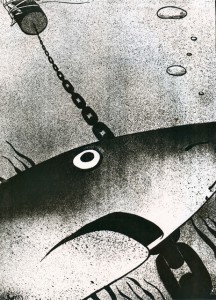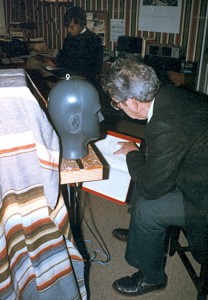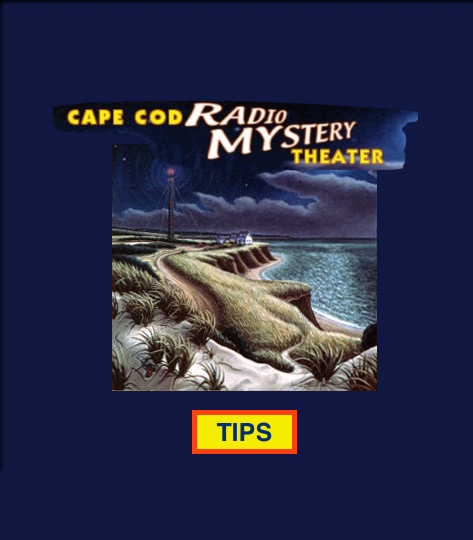Posted in Liner Notes, What's New
‘THE BUOY’
NOTES ON THE PROGRAMS:
Recorded at: HT Recording Studio, Dennis, Cape Cod
Rosemead Studio, Los Angeles
Play’s location: Off Penzance Point in the Woods Hole Passageway
First broadcast: ?
Trivia: ‘The Buoy’ is a Pit-and-the-Pendulum-style radio thriller. We tried to really pull out all the stops with this one. We were calling it a ‘Soundscape’ mystery.
Cast in order: Announcer . . . . . . . . . . . . . . Floyd Pratt
Inkeeper . . . . . . . . . . . . . . . Carol McManus
David Halpole . . . . . . . . . .Thom Dutton*
Edward Wolcott . . . . . . . .George McConville
Men on Boat . . . . . . . John Todd, Steven Oney
Recording engineers. . . . . . . Mark Birmingham John Todd, Steve Oney,
Music by . . . . . . . . . . . . . . . Mark Birmingham
(*) First appearance in a CCRMT program
Author’s Notes and Recollections:
‘The Buoy’ was the eleventh CCRMT production and our third suspense thriller. Our first suspense show, ‘The Caller on Line One’ was built around a radio call-in show; the second, ‘The Hypnotist’ more atmospheric, took place inside a hospital room as well as inside the mind of a woman trapped in a coma; with the third ‘The Buoy’ we wanted to make it a Soundscape mystery, very wrap-around and atmospheric and use some of the choice sound effects Cape Cod is particularly known for (e.g. repeating foghorns with opposite-shore echo, sloshing and gonging bell buoys, gurgling water and currents, groaning mooring chains, single boats chugging past, solitary planes flying overhead). The story would be a First Person narrative with simultaneous enactment of action by using sound effects.
As much as anything else, this would be a story in which music would be paramount, not just a supportive underscoring, but a score that moves like the tidal current and not only sweeps the listener up but chills her to the bone. Mark was really psyched about how he wanted to handle it. (He envisioned a little bit of Sibelius, a lotta-bit of Rachmaninoff’s ‘Isle of the Dead’) While the dialogue was recorded at HT Recording Studio, the show was assembled in Hollywood at Rosemead Studio a block off Hollywood and Vine.
The goal was to put the listener right out on the buoy that the victim is bound too and immerse them in array the sound effects occurring all around them. Before recording began Mark and I experimented with a dummy’s head (not mine or his although there was some experimenting there as well) but a dummy’s head that consisted of twin miniature microphones implanted inside a mannequin’s head. It was the most novel audio gear of the time and supposed to give a real 3-D effect that exactly mimicked what a set of human ears experiences naturally. We found it worked cleverly for certain kinds of sound effects, but not so well with others. It was also distracting and, we further realized, it was not really needed for this kind of story which, after all, consisted almost entirely of single-voice narration, no dialogue. Mark decided we could achieve the effects we were looking for by simple manipulation of the pan pots and gain. He was the guiding sound designer on this project.
Many of the sound effects we used were laboriously recorded in the field, requiring many hours and sometimes multiple attempts. There is a good one of the Woods Hole ferry departing the dock, and excellent ones of bell buoys (they were recorded in dry dock at the Woods Hole Coast Guard Station –thanks guys.) Mark loaded them into his Synclavier so they could be played like musical notes on keyboard. The best sound effect in the show, however, I think is the groaning of the buoy’s anchor chain when buoy wakes up (SPOILER ALERT). It was actually the squeaky lid of an empty garbage dumpster rolled around on castors.
The story itself owes a great homage to Edgar Allan Poe, particularly his ‘Pit and the Pendulum’ story but there were other influences as well. I’ll mention a few: First, the Woods Hole Passage itself, which for anyone any one who has ever been through it, particularly in a small boat, knows what a thrilling ride it is. The way the galloping current suddenly seizes your keel and wrestles you with the tiller. Secondly, the Woods Hole Harbor itself, one of the most flavorful and dramatic parts of the Cape and said to be ‘shark infested’. (Many recall only a few years back when a female Great White Shark cruised into one of Woods Hole’s nearby inlets and either couldn’t find its way out or refused to leave for several weeks).
A third influence comes from in a true story that happened to my in-laws when they were freshly married and piloting a small sailboat through the Passage heading East from New Bedford –And for this story it helps if you are familiar with the John Singleton Copley painting called ‘Watson and the Shark’ (The original is in the National Gallery of Art, Washington, D.C. There is also a life-size copy by the artist in the Boston Museum of Fine Arts)—
They had just made it through and were angling across the harbor when another small sailboat ahead capsized and they steered over to offer assistance. Arriving, they were just hauling the skipper onto their boat when a large shark –possibly a Bull shark—swam up and, very much like the painting, took a nearly successful swipe at the sailor’s leg just as they got aboard.
The Cast
Carol McManus, who has trod many stages as both director and actress on Cape Cod and one of the founders of the Glass Town Players in Sandwich, turns in a fun cameo as the mysterious Innkeeper. Thom Dutton, who also plays a mean harp, appears as the properly awestruck David Halpole. Everyone agrees Floyd Pratt does a great job with his gravely voiced opening monologue that sets the proper sense of ghostly dread. Of all Floyd’s appearances, I think this one his best.
However, the biggest kudos must go to George McConville who plays the lead role and who at the time was probably the best known and most venerated actor on the Cape, especially for his appearances at the Harwich Junior Theater. (George also appears in CCRMT’s ‘The Curse of the Whale’s Tooth’ and in ‘Mr. Hugo’s Night to Remember’ but this performance in this production is undoubtedly his signature piece.)





How marvelous to have these notes! I’m a big fan of the Underhill mysteries, but The Buoy has long been my single favorite episode. It’s CCRMT firing on all cylinders, great plotting, sound effects, atmosphere. Thanks for all the great shows and now for notes that help me enjoy the shows in a new way!
Always wondered who Mr. Halpole was talking to since the man on the buoy was rescued.This one really keep you on the edge of your chair..
I am still kept up at night whenever I am in a motel on the Cape wondering WHY ??? Will we ever know why Mr. Walcott was kidnapped and left for dead? It seems utterly random and unfair. Also, I have always assumed that he did not survive, and that it was his specter who told his story to warn Mr. Walcott of the fate that must have been awaiting him!
When he gets rescued, and they keep saying “breathe, breathe” you hear him take a deep breath of him surviving, or so I assumed.
I always assumed that Wolcott did not survive. If he did then the rest of the story makes no sense. Just because the help arrives doesn’t mean that it was in time. Even if he was breathing he might have died from a heart attack, shock or exposure.